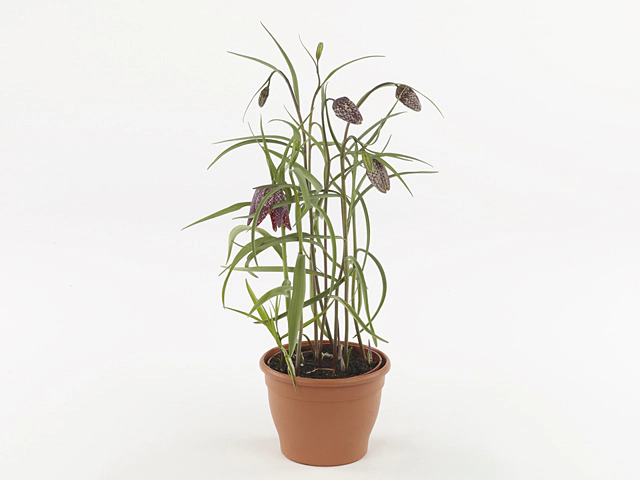Fritillaria meleagris

| Flower type | Single |
| Flower color | Red-dark purple red-059B; White-white-NN155A |
| Leaf, general shape | Linear |
| Flower diameter | 3,5 - 4 cm |
| Plant height | 30 - 40 cm |
| Flower length/hight | 4,5 - 5 cm |
| Inflorescence | Few-flowered; Single-flowered |
| Leaf width | 1 - 2 cm |
| Leaf size | 10 - 15 cm |
| Leaf division | Simple |
| Plant, growth type | Erect |
| Leaf, main color | Medium green |
| Leaf colour, pattern | Unicolored |
| Flower color distribution | Feathered; Multi-colored |
| Flower, secondary color(s) | Pink-medium blue pink-186D |
The Fritillaria meleagris, also known as the Fritillary or Checkered Lily, is a stunning flower that also goes by the name Snake's Head due to its unique pattern. This beautiful flower is native to Europe and is highly sought after by gardeners for its striking appearance.
The Fritillary features single flowers that come in various colors. The most common colors are red-dark purple-red and white. The flower has a diameter of 3.5 to 4 cm and a length of about 4.5 to 5 cm when fully bloomed.
The plant itself can reach a height of 30 to 40 cm, making it an ideal addition to garden borders or containers. The inflorescence of the Fritillary is few-flowered or single-flowered, making each bloom stand out in its own right.
The leaves of this plant are linear in shape, with a width ranging from 1 to 2 cm. The size of the leaves measures about 10 to 15 cm. They are simple in division and have a medium green color. The leaf color is uniform and does not have any patterns or variegation.
One of the distinctive features of the Fritillary is its flower color distribution. The petals of the flower are feathered, giving them a unique texture. The colors are also multi-colored, adding to the visual appeal of the plant. Along with the primary colors mentioned earlier, the flower may also have secondary colors such as pink and medium blue-pink.
The Fritillary is a relatively easy plant to grow, as it has an erect growth habit. It thrives in well-draining soil and prefers a sunny or partially shaded location. It can be planted in the spring or fall, and the flowers typically bloom in the late spring or early summer.
In the garden, the Fritillary adds a touch of elegance and charm with its vibrant colors and delicate petals. It is a popular choice for creating a focal point or adding a splash of color to a flower bed. The Fritillary also attracts pollinators such as bees and butterflies, making it a valuable addition to any garden ecosystem.
Whether you are a seasoned gardener or just starting out, the Fritillary is a flower that is sure to impress. Its stunning colors and unique pattern make it a standout choice for anyone looking to enhance their garden's beauty. So why not consider adding the Fritillary to your collection and enjoy the beauty it brings throughout the season?
Market availability index by month:
| Jan. | Feb. | Mar. | Apr. | May | Jun. | Jul. | Aug. | Sep. | Oct. | Nov. | Dec. |
|---|---|---|---|---|---|---|---|---|---|---|---|
| 1 | 2 | 2 | 3 | 4 | 2 | 1 | 2 | 2 | 1 | 1 | 1 |